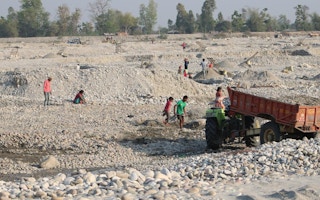While the need for recognising and upholding human rights in transboundary river governance systems has been highlighted, ways businesses impact human rights in these systems is least explored.
The transboundary rivers of South Asia, such as the Ganges, Brahmaputra, Meghna (GBM) and Indus, and the riverine communities dependent on these rivers for their livelihoods are facing unprecedented changes due to large scale infrastructure development in and around these rivers to meet the increasing demands for water, energy, food and trade in the region.
This is in addition to climate-induced changes and other natural hazards, like floods and droughts, in many of these basins.
Businesses play a critical role in many of these infrastructure development, including those to mitigate and reduce the risks of natural hazards, such as the construction of flood protection embankments or reservoirs to mitigate drought risks.
“
Transboundary river systems provide a variety of ecosystem services and through this connect countries and communities across political boundaries.
Growing demands for sand and aggregates for construction and real estate sector in the region has been fueling unsustainable and unregulated sand and river bed mining on many of the river basins in the region.
A complex nexus of corruption and crimes operate in the sand mining enterprise in many of these basins, including threats to lives of environmental human rights defenders (EHRDs), river activists and journalists. For example, many activists and journalists trying to expose the sand mining violation and corruption in India are being targeted, threatened and attacked.
Governments and businesses in the region are currently investing in various regional trade and connectivity projects, and many of these are directly or indirectly linked to shared rivers and riverine resources. For example, Nepal, Bangladesh and India are jointly working to further improve inland water transport (IWT) in the transboundary rivers of Ganges and Brahmaputra to boost trade through as part of multi-modal regional connectivity.
Recently, India and Bangladesh signed the Second Addendum on Protocol on Inland Water Transit and Trade between India and Bangladesh (20 May 2020). With this, the number of Indo Bangladesh Protocol (IBP) routes and Ports of Call has been increased and new opportunities for cargo movement explored.
It is in this emerging context of increased business investments to extract and use river resources and the need to ensure the protection of human rights, that we need to collectively work towards better integration of business and human rights in transboundary river governance in South Asia.
As part of our on-going TROSA initiative, we recently conducted a regional analysis of water, business and human rights in the basins we work. Based on the findings, we suggest the following five areas of action and encourage governments and businesses to integrate and build more business and human rights elements in transboundary river governance in South Asia:
1. Improve businesses’ awareness and engagement on human rights in transboundary water issues
To ensure more participation, buy-in and leadership of the businesses and private investors, it is important to improve understanding and awareness on various international human rights standards and emerging initiatives on responsible business, particularly those related to the environment such as land use and water.
The UN Guiding Principles on Business and Human Rights (UNGPs)—which outline the various obligations of governments and business with regards to human right—is a useful starting point, as is the UN’s Framework Principles on Human Rights and the Environment.
Civil society organisations (CSOs) and other human rights network can play a facilitatory role by working with industry associations, SME clusters and private investors at the country and regional levels in South Asia. More action on awareness-raising and engagement are needed across value chains and in ancillary services around large infrastructure projects.
Many South Asia countries are currently working on their National Action Plans (NAPs) on business and human rights developed to guide government alignment with the UNGPs. These are unique opportunities for such awareness generation and participation, and to determine priorities for action.
New insights and skills can also be gathered through initiatives like the CEO Water Mandate and the newly launched Water Resilience Coalition. For example, major apparel brands such as Gap Inc., Levi Strauss & Co, and PVH Corp, have established a location-based water stewardship initiative in India’s Cauvery basin where they operate and source from.
In addition to setting up examples on corporate water stewardship, this has triggered collaboration on water quality, groundwater management and other water challenges in the basin.
2. Integrate more human rights-based approach (HRBAs) and gender equality in regulatory frameworks such as Environment Impact Assessment (EIA) and Strategic Environment Assessment (SEA)
Infrastructure developers, investors and regulators should work together to revise some of the existing EIA guidelines to include more human rights-based and gender equality dimensions.
These should be more context-specific and take into account the rights of indigenous communities and differential needs and aspirations of women and men concerning water use in these basins.
Large infrastructure projects in and around the rivers, some of which pass through biodiverse rich regions such as protected areas inhabited by indigenous communities, involve dredging, deforestation, water diversion, blasting and mining. For comprehensive impact assessments at basin levels, inclusive and participatory Strategic Environment Assessments (SEAs) should be conducted.
The EIAs, SEAs and other project appraisal and approval mechanisms by governments and financiers should ensure human rights and gender equality aspects are integrated into the social and economic impact analyses, and the mitigation measures are put in place in consultation with the stakeholders.
For example, AIIB’s water sector analysis and the resulting Water Sector Strategy recognise the need to include gender dimensions and its interaction with other factors like class, ethnicity and geography while investing in water projects.
A detailed analysis of the inclusion of gender in EIA by India’s Center for Science and Environment (CSE, 2018) highlights the benefits of gender inclusion in EIA and presents use cases from around the world. The new Hydropower Benefit Sharing guide developed by the International Hydropower Association (IHA) provides tools and approaches for developers and operators to meet good practices.
Nepal has shown ways by institutionalising such measures in the form of the purchase of local shares which gives communities a constitutional right to invest in hydropower companies developing a project in their area.
According to IFC’s estimates, so far more than $10 million in equity has been raised in last three years and it is projected to raise $439 million in equity from project-affected communities in next ten years.
3. Initiate multi-stakeholder partnerships (MSPs) at the basin, sub-regional and regional levels on responsible and inclusive business
Partnership is key to mobilise more collective action and stimulate political commitment among businesses, financiers and governments for responsible business practices in water governance. Multi-stakeholder partnerships (MSPs) could be thematic such as MSPs on responsible fisheries, sustainable sand mining, river tourism or inland water trade. Business investment impacts are often cross-sectoral.
For example, investments in large river tourism infrastructure development could have negative impacts on water quality or fish habitat or threaten local cultural practices. And most of these impacts are transboundary in shared water systems. Basin, sub-regional and regional MSPs could help better understand and address some of these transboundary inter-linkages and impacts.
South Asia is one of the least connected and integrated regions in the world. But with growing intra-regional trade initiatives and cooperation on energy, connectivity and tourism, there is an urgent need for regional and other sub-regional initiatives like the Bangladesh Bhutan India Nepal (BBIN), the South Asia Subregional Economic Cooperation (SASEC), and the Bay of Bengal Initiative for Multi-Sectoral Technical and Economic Cooperation (BIMSETC) to explore and integrate more responsible and inclusive business practices in cross-border investments and trade agreements.
Multilateral development banks like the Asian Development Bank (ADB), World Bank and the International Finance Corporation (IFC), and the Asian Infrastructure Investment Bank (AIIB) and other bilateral donors could play a role in some of the regional level MSPs on responsible business.
One such example is the recently launched Plastic Free Rivers and Seas for South Asia project led by the South Asia Co-operative Environment Programme (SACEP)—an inter-governmental organisation. Among others, it aims to leverage private sector engagement and solutions to reduce plastic pollution through multi-sector dialogues and partnerships in South Asia.
4. Institutionalise frameworks for high-quality regulation including transparency and commitment to fight corruption
Regulatory frameworks around private sector activity, environmental protection and water resource management must prioritise public access to environmental information, and public participation in decision-making. Too often affected communities and CSOs are excluded from the decision-making process, and dialogues on private sector activity and development.
Women’s understanding of the use, sharing and conservation of water resources is key to better water governance, yet their voices are rarely heard in decision-making forums. Decision-making processes must be inclusive of affected communities, including women, Indigenous Peoples and human rights defenders, and be based on a commitment to transparency.
Irresponsible business practice is often enabled by corruption. Fighting corruption must be part of how all stakeholders rethink business and human rights in transboundary river governance in South Asia. The UN Working Group on Business and Human Rights is currently undertaking work aimed at better connecting the business and human rights and anti-corruption agendas.
The outcomes of this work may usefully inform policy responses to business and human rights issues in South Asia, particularly in sectors where corruption is prevalent.
5. Incentivise and increase private finance towards the sustainable river and water governance
Transboundary river systems provide a variety of ecosystem services and through this connect countries and communities across political boundaries. Impacts, as well as benefits, from businesses and investments in these river systems, are mostly transboundary in nature.
Harmful business practice in one part of the basin can have negative downstream impacts such as pollution and threat to livelihoods. Riparian basin states should work with businesses to support and incentivise responsible business practices that take in to account such cross-border impacts and put in place required risk mitigation measures.
For example, the European Union’s Generalised Scheme of Preferences (GSP+) offers special trade incentives for countries that implement 27 international conventions related to human rights, labour rights, protection of the environment and good governance South Asia countries are already benefiting from this.
With growing traction among commercial and investment banks for sustainability performance, businesses can improve their capacity and commitment to social and environmental standards in their business practices, including the commitment to the Sustainable Development Goal (SDG) 6 targets on improving water quality (Target 6.3), increasing water use efficient (Target 6.4) and implementing Integrated Water Resources Management, IWRM (Target 6.5).
Banks and investors from South Asia should also take advantage of the opportunities through the recently launched Principles of Responsible Banking and the Global Investors for Sustainable Development (GISD)
Oxfam and partners have long encouraged more multi-stakeholder dialogues and partnerships to strengthen responsible and inclusive business that respect human rights and other environmental needs in these river systems.
As governments, businesses, civil society and human rights organisations convene for the United Nations Virtual Forum on Responsible Business and Human Rights we hope the needs and opportunities for inclusion and advancement of business and human rights in transboundary river governance are recognised and collective action initiated.
Jyotiraj Patra is project manager of Transboundary Rivers of South Asia (TROSA) at Oxfam. Christina Hill is an independent consultant for business, human rights, gender and corporate accountability. This article was originally published on the Oxfam blog.










